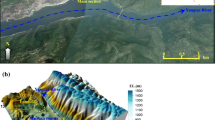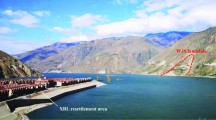Abstract
The Qianjiangping landslide occurred on July 13, 2003 when water level in the Three Gorges Reservoir in China reached 135 m a.s.l. for about 1 month. Thirteen people on the slope and 11 fishermen on boats in the nearby area were killed by this landslide and its wave. As a typical case, the Qianjiangping landslide is researched extensively, but the wave itself was studied much less. In this paper, a fluid–solid coupling model based on general moving objects (GMO) collision model and renormalisation group (RNG) turbulent model were employed, simplifying the sliding motion of the Qianjiangping landslide as a rigid body circular motion whose validity was verified by comparing with actual survey conditions related. Numerical simulation analysis shows that in the Qianjiangping landslide event, the solid–fluid energy-transferring rate was 5.97 %, while the motion of sliding mass could push and raise water body. The maximum-modelled wave run-up generated by the Qianjiangping landslide was 40.4 m (up to 175.4 m a.s.l.), while the maximal observed one was 39 m. It was the solitary wave, and the wave celerity was 32∼36 m/s or so. The hazardous river length of impulse wave was estimated to be 12.6 km, where wave height was more than 1 m high. The fluid–solid coupling numerical model employed by this paper can provide important reference for wave generated by other landslides around the world. Research of the landslide-generated wave is very significant in landslide hazard reduction and prevention.













Similar content being viewed by others
References
Abadie S, Morichon D, Grilli S, Glockner S (2010) Numerical simulation of waves generated by landslides using a multiple-fluid Navier–Stokes model. Coast Eng 57:779–794
Basu D, Green S, Das K, Janetzke R, Stamatakos J (2009) Numerical simulation of surface waves generated by a sub-aerial landslide at Lituya Bay, Alaska. Proceedings of OMAE 2009, 28th International Conference on Ocean, Offshore and Arctic Engineering, 1–14
Bosa S, Petti M (2011) Shallow water numerical model of the wave generated by the Vajont landslide. Environ Model Softw 26:406–418
Choi BH, Kim DC, Pelinovsky E, Woo SB (2007) Three-dimensional simulation of tsunami run-up around conical island. Coast Eng 54:618–629
Choi BH, Pelinovsky E, Kim DC, Didenkulova I, Woo SB (2008) Two- and three-dimensional computation of solitary wave run-up on non-plane beach. Nonlinear Process Geophys 15:489–502
Das K, Janetzke R, Basu D, Green S, Stamatakos J (2009) Numerical simulations of tsunami wave generation by submarine and aerial landslides using RANS and SPH models. Proceedings of OMAE 2009, 28th International Conference on Ocean, Offshore and Arctic Engineering, 1–14
Flow Science (2012) FLOW-3D V10.1 user’s manual. Flow Science Inc, Los Alamos
Fritz HM, Hager WH, Minor HE (2003) Landslide generated impulse waves-2. Hydrodynamic impact craters. Exp Fluids 35:520–532
Fritz HM, Hager WH, Minor HE (2004) Near field characteristics of landslide generated impulse waves. J Waterw Port Coast Ocean Eng 130:287–302
Heller V, Hager WH (2011) Wave types of landslide generated impulse waves. Ocean Eng 38:630–640
Jiang Q, Zhang Z, Wei W, Xie N, Zhou C (2012) Research on triggering mechanism and kinematic process of Qianjiangping landslide. Disaster Adv 5(4):631–636
Li H, Wang T, Duan W (2006) Characteristics and mechanism of Qianjiangping landslide in Three Gorges Reservoir area. Rock Soil Mech 27(supplement):1239–1244
Li S, Li X, Wu J, Liu Y (2007) Evolution process and pattern of sliding zone in large consequent bedding rock landslide. Chin J Rock Mech Eng 12(26):2473–2480
Liao Q, Li X, Souting L, Dong Y (2005) Occurrence, geology and geomorphy characteristics and origin of Qianjiangping landslide in Three Gorges Reservoir area and study on ancient landslide criterion. Chin J Rock Mech Eng 24(17):3146–3153
Luo X, Xiao S, Wang S et al (2005) Engineering geological exploration report on Qianjiangping landslide of Zigui County, Three Gorges Reservoir. China Three Gorges University, China
Montagna F, Bellotti G, Di Risio M (2011) 3D numerical modeling of landslide-generated tsunamis around a conical island. Nat Hazards 58:591–608
Murty TS, Rao AD, Nirupama N, Nistor I (2006) Numerical modelling concepts for Tsunami warning systems. Curr Sci 90(8):1073–1081
Murty TS, Aswathanarayana U, Nirupama N (2007) The Indian Ocean tsunami. Taylor & Francis, London
Nirupama N, Murty TS, Rao AD, Nistor I (2005) Numerical tsunami models for the Indian Ocean countries and states. Indian Ocean Surv 2(1):1–14
Pastor M, Herreros I, Fernández Merodo JA, Mira P, Haddad B et al (2009) Modeling of fast catastrophic landslides and impulse waves induced by them in fjords, lakes and reservoirs. Eng Geol 109:124–134
Serrano-Pacheco A, Murillo J, García-Navarro P (2009) A finite volume method for the simulation of the waves generated by landslides. J Hydrol 373:273–289
Wang D, Li K (2007) Study on Qianjiangping landslide due to reservoir water level rise. Disaster Control Eng 2:15–19
Wang Z, Yang R (2006) The activity characteristics and movement style of Qianjiangping landslide in the Three Gorges Reservoir region. Chin J Geol Hazard Control 16(3):5–11
Wang F-W, Zhang Y-M, Huo Z-T, Matsumoto T, Huang B-L (2004) The July 14, 2003 Qianjiangping landslide, Three Gorges Reservoir, China. Landslides 1:157–162
Wang F-W, Zhang Y, Huo Z, Peng X, Wang S, Yamasaki S (2008) Mechanism for the rapid motion of the Qianjiangping landslide during reactivation by the first impoundment of the Three Gorges Dam reservoir, China. Landslides 5:379–386
Watts P, Grilli ST, Kirby JT et al (2003) Landslide tsunami case studies using a Boussinesq model and a fully nonlinear tsunami generation model. Nat Hazards Earth Syst Sci 3:391–402
Wen B, Shen J, Tan J (2008) The influence of water on the occurrence of Qianjiangping landslide. Hydrogeol Eng Geol 3:12–17
Wu A, Ding X, Li H, Chen S, Shi G (2006) Numerical simulation of startup and whole failure process of Qianjiangping landslide using discontinuous deformation analysis method. Chin J Rock Mech Eng 26(12):2473–2480
Wu J, Zhang Z, Liu Y (2007) Study on high-velocity mechanism of Qianjiangping landslide. J China Three Gorges Univ Nat Sci 29(2):120–123
Xiao S, Liu D, Hu Z (2010a) Study of high velocity slide mechanism of Qianjiangping landslide in Three Gorges Reservoir area. Rock Soil Mech 31(11):3531–3536
Xiao S, Liu D, Jiang F, Jiang X (2010b) Geomechanical model experiment on Qianjiangping landslide in Three Gorges Reservoir area. Chin J Rock Mech Eng 29(5):1023–1030
Yin Y, Peng X (2007) Failure mechanism on Qianjiangping landslide in the Three Gorges Reservoir region. Hydrogeol Eng Geol 3:51–54
Yin K, Liu Y, Wang Y, Jiang Z (2012) Physical model experiments of landslide-induced surge in Three Gorges Reservoir. Earth Sci J China Univ Geosci 37(5):1067–1074
Zhang Y, Liu G, Chang H, Huang B, Pan W (2004) Tectonic analysis on the Qianjiangping landslide in Three Gorges Reservoir area and a revelation. J Yangtze River 35(9):24–26
Zhao Y, Cui P, Hu L, Tomasz H (2011) Multi-scale chemo-mechanical analysis of the slip surface of landslides in the Three Gorges, China. Sci China Technol Sci 54(7):1757–1765
Acknowledgments
This work was supported by the National Natural Science Foundation of China (ID 41372321), the China Geological Survey (ID 1212011014027), and the National Science and Technology Support (ID 2012BAK10B01). The authors would like to thank Yu Zubing from Flow Science and Huo Zhitao from the China Geological Environmental Monitoring Institute; they are of great help for this paper. Meanwhile, when the authors participated in the emergency investigation on the Qianjiangping landslide in July 2003, Prof. Pen Xuanming, Prof. Pan Wei, and Prof. Zhang Yeming gave much help; their help is appreciated.
Author information
Authors and Affiliations
Corresponding author
Rights and permissions
About this article
Cite this article
Yin, Yp., Huang, B., Chen, X. et al. Numerical analysis on wave generated by the Qianjiangping landslide in Three Gorges Reservoir, China. Landslides 12, 355–364 (2015). https://doi.org/10.1007/s10346-015-0564-7
Received:
Accepted:
Published:
Issue Date:
DOI: https://doi.org/10.1007/s10346-015-0564-7




